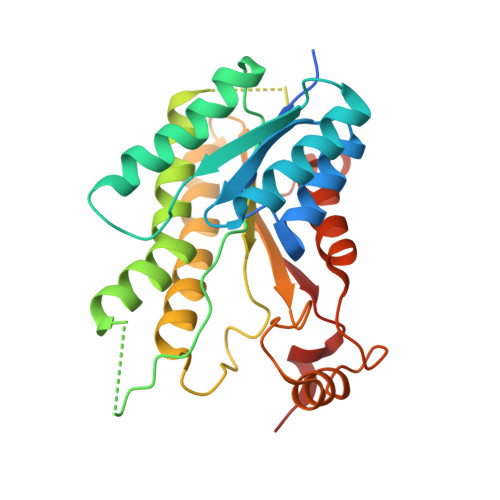The discovery of aryl-2-nitroethyl triamino pyrimidines as anti-Trypanosoma brucei agents.
Linciano, P., Pozzi, C., Tassone, G., Landi, G., Mangani, S., Santucci, M., Luciani, R., Ferrari, S., Santarem, N., Tagliazucchi, L., Cordeiro-da-Silva, A., Tonelli, M., Tondi, D., Bertarini, L., Gul, S., Witt, G., Moraes, C.B., Costantino, L., Costi, M.P.(2023) Eur J Med Chem 264: 115946-115946
- PubMed: 38043491
- DOI: https://doi.org/10.1016/j.ejmech.2023.115946
- Primary Citation of Related Structures:
8OF2 - PubMed Abstract:
Pteridine reductase 1 (PTR1) is a catalytic protein belonging to the folate metabolic pathway in Trypanosmatidic parasites. PTR1 is a known target for the medicinal chemistry development of antiparasitic agents against Trypanosomiasis and Leishmaniasis. In previous studies, new nitro derivatives were elaborated as PTR1 inhibitors. The compounds showing a diamino-pyrimidine core structure were previously developed but they showed limited efficacy. Therefore, a new class of phenyl-, heteroaryl- and benzyloxy-nitro derivatives based on the 2-nitroethyl-2,4,6-triaminopyrimidine scaffold were designed and tested. The compounds were assayed for their ability to inhibit T. brucei and L. major PTR1 enzymes and for their antiparasitic activity towards T. brucei and L. infantum parasites. To understand the structure-activity relationships of the compounds against TbPTR1, the X-ray crystallographic structure of the 2,4,6-triaminopyrimidine (TAP) was obtained and molecular modelling studies were performed. As a next step, only the most effective compounds against T. brucei were then tested against the amastigote cellular stage of T. cruzi, searching for a broad-spectrum antiprotozoal agent. An early ADME-Tox profile evaluation was performed. The early toxicity profile of this class of compounds was investigated by measuring their inhibition of hERG and five cytochrome P450 isoforms (CYP1A2, CYP2C9, CYP2C19, CYP2D6 and CYP3A4), cytotoxicity towards A549?cells and mitochondrial toxicity. Pharmacokinetic studies (SNAP-PK) were performed on selected compounds using hydroxypropyl-¦Â-cyclodextrins (50?% w/v) to preliminarily study their plasma concentration when administered per os at a dose of 20?mg/kg. Compound 1p, showed the best pharmacodynamic and pharmacokinetic properties, can be considered a good candidate for further bioavailability and efficacy studies.
Organizational Affiliation:
Department of Life Sciences, University of Modena and Reggio Emilia, Via Campi 103, 41125, Modena, Italy.


















